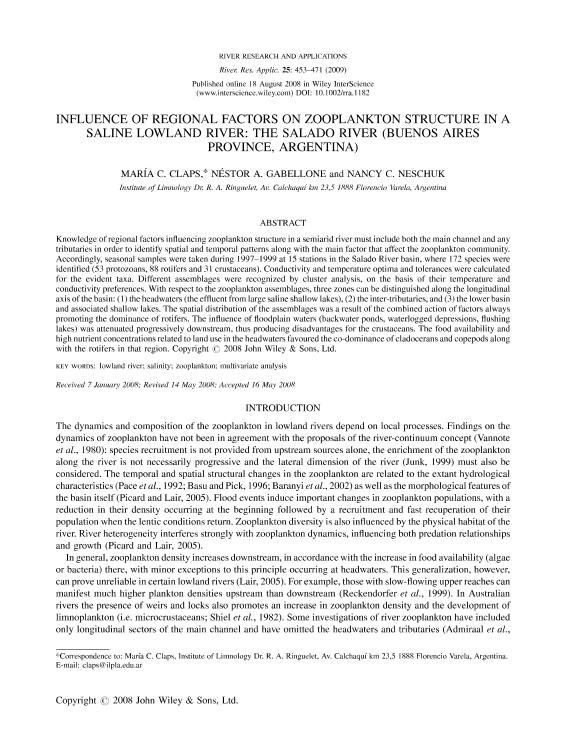Artículo
Influence of regional factors on zooplankton structure in a saline lowland river: the Salado River (Buenos Aires province, Argentina)
Fecha de publicación:
08/2008
Editorial:
Wiley
Revista:
River Research And Applications
ISSN:
1535-1459
Idioma:
Inglés
Tipo de recurso:
Artículo publicado
Clasificación temática:
Resumen
Knowledge of regional factors influencing zooplankton structure in a semiarid river must include both the main channel and any tributaries in order to identify spatial and temporal patterns along with the main factor that affect the zooplankton community. Accordingly, seasonal samples were taken during 1997–1999 at 15 stations in the Salado River basin, where 172 species were identified (53 protozoans, 88 rotifers and 31 crustaceans). Conductivity and temperature optima and tolerances were calculated for the evident taxa. Different assemblages were recognized by cluster analysis, on the basis of their temperature and conductivity preferences. With respect to the zooplankton assemblages, three zones can be distinguished along the longitudinal axis of the basin: (1) the headwaters (the effluent from large saline shallow lakes), (2) the inter-tributaries, and (3) the lower basin and associated shallow lakes. The spatial distribution of the assemblages was a result of the combined action of factors always promoting the dominance of rotifers. The influence of floodplain waters (backwater ponds, waterlogged depressions, flushing lakes) was attenuated progressively downstream, thus producing disadvantages for the crustaceans. The food availability and high nutrient concentrations related to land use in the headwaters favoured the co-dominance of cladocerans and copepods along with the rotifers in that region.
Palabras clave:
Lowland River
,
Salinity
,
Zooplankton
,
Multivariate Analysis
Archivos asociados
Licencia
Identificadores
Colecciones
Articulos(ILPLA)
Articulos de INST.DE LIMNOLOGIA "DR. RAUL A. RINGUELET"
Articulos de INST.DE LIMNOLOGIA "DR. RAUL A. RINGUELET"
Citación
Claps, Maria Cristina; Gabellone, Nestor Adrian; Neschuk, Nancy Carolina; Influence of regional factors on zooplankton structure in a saline lowland river: the Salado River (Buenos Aires province, Argentina); Wiley; River Research And Applications; 25; 4; 8-2008; 453-471
Compartir
Altmétricas




